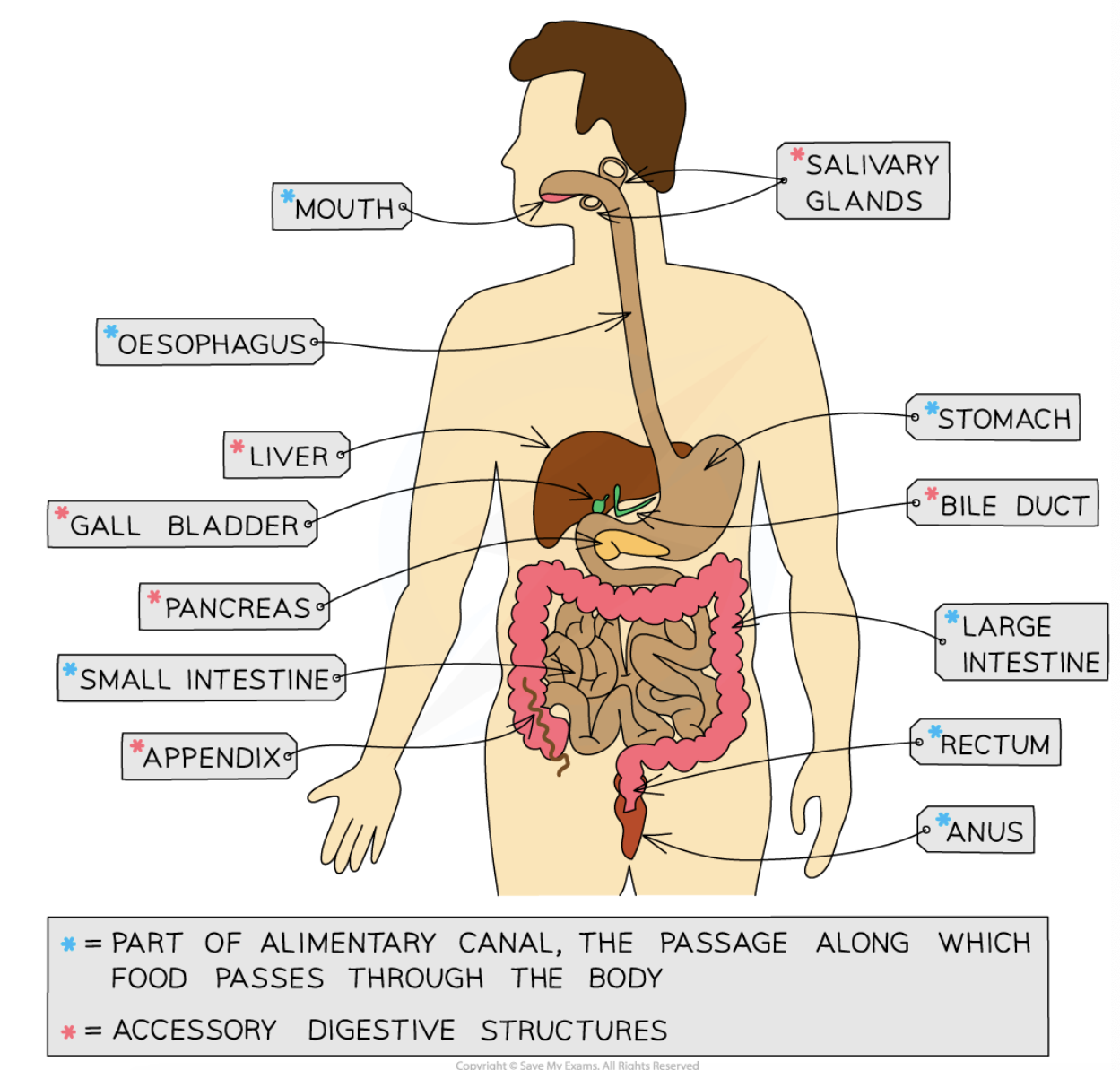the human digestive system
1/25
There's no tags or description
Looks like no tags are added yet.
Name | Mastery | Learn | Test | Matching | Spaced |
|---|
No study sessions yet.
26 Terms
what is the digestive system?
The digestive system is an example of an organ system in which several organs work together to digest and absorb food
what is digestion?
digestion is a process in which relatively large, insoluble molecules in food are broken down into smaller, soluble molecules that can be absorbed into the bloodstream and delivered to cells in the body
2 examples of large insoluble food molecules
starch, proteins
what are the products of digestions used for?
These small soluble molecules are used either to
provide cells with energy (via respiration),
or with materials with which they can build other molecules to grow, repair and function
what is the human digestive system made up of (2)
The human digestive system is made up of the organs that form the alimentary canal and accessory organs

what is the alimentary canal?
The alimentary canal is the channel or passage through which food flows through the body, starting at the mouth and ending at the anus. Digestion occurs within the alimentary canal.
what are accessory organs? what do they do?
Accessory organs produce substances that are needed for digestion to occur (such as enzymes and bile) but food does not pass directly through these organs
how many organs are in the alimentary canal?
7
how many are accessory organs?
3
what is the order of organs in which the food passes through?
mouth/salivary glands
oesophagus
stomach
small intestine
large intestine
rectum
anus
list all of the organs involved in digestion
mouth/salivary glands
oesophagus
stomach
small intestine
large intestine
rectum
anus
pancreas
liver
gall bladder
describe the role of the mouth in digestion (4)
site of mechanical digestion - teeth chew food to break into smaller pieces + increase surface area to volume ratio
site of chemical digestion - salivary glands produce saliva
- amylase in saliva digest starch into maltose
food shaped into bolus by tongue and lubricated in saliva for easy swallowing
describe the role of the oesophagus in digestion (3)
tube that connects mouth to stomach
where bolus goes after swallowing
mechanical digestion - involuntary muscle movement (peristalsis) to push down the food, also mechanical digestion
describe the role of the stomach in digestion (3)
site of mechanical digestion - churning
site of chemical digestion - protease enzymes (pepsin) digest proteins
HCl - present to kill bacteria in food + provide optimum conditions for pepsin to work
describe the role of the small intestine in digestion (4)
2 sections: duodenum and ileum
duodenum - finish digestion with all 3 enzymes produced by the pancreas in alkaline solution
bile from accessory organs neutralises stomach acid for optimum enzyme pH and to emulsify fat
ileum - absorption of digested food molecules (by diffusion). long and villae lined to increase surface area over which absorption can take place
describe how villi helps with absorption in the small intestine (6)
Villi are adaptations of the small intestine that increase the efficiency of digestion and absorption of nutrients. They are tiny, finger-like projections lining the intestine, providing a large surface area to absorb digested food efficiently.
increase the surface area for absorption, allowing more nutrients to be absorbed at once.
The walls of villi are only one cell thick, meaning that digested molecules (like glucose and amino acids) can diffuse quickly into the blood.
Each villus has a dense network of capillaries, which maintains a steep concentration gradient, ensuring rapid diffusion and transport of absorbed nutrients into the bloodstream.
describe the role of the large intestine in digestion (1)
water, vitamins and minerals absorbed from remaining material in the colon to produce faeces
describe the role of the rectum in digestion (1)
stores faeces
describe the role of the anus in digestion (1)
removes faeces
describe the role of the pancreas in digestion (2)
produce all 3 types of digestive enzymes (amylase, protease and lipase)
secretes enzymes in alkaline fluid into the duodenum for digestion to raise pH of fluid coming out of the stomach
describe the role of the liver in digestion (2)
produces bile
amino acids broken down here to produce urea
what is the role of bile in digestion (2)
emulsify fat (break large droplets into smaller droplets) for mechanical digestion
neutralise stomach acid
what is the role of the gall bladder in digestion (1)
stores bile to release into duodenum
a little bile cabinet
what does the large intestine contain
hundreds of species of bacteria
These bacteria form a microbial ecosystem (the microbiota, or gut flora)
why is the microbiota important in human digestion (4)
Breaking down substances we can’t digest (like cellulose)
Supplying essential nutrients
Synthesising vitamin K
Providing competition with any harmful bacteria to restrict their growth
how and why can taking antibiotics affect digestion?
Taking antibiotics can disrupt the gut microbiota which can cause short-term problems with digestion